Unseen Victims: Iran’s Regime and the Deadly Impact on the Environment
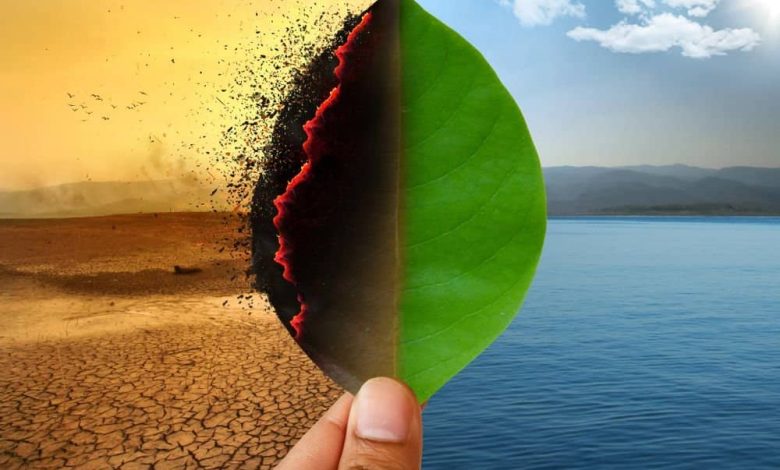
A Legacy of Environmental Destruction (1)
Written by
Mohammad Sadat Khansari
In recent years, Iran has been grappling with an unprecedented environmental catastrophe, and the situation has only worsened due to the disastrous policies of the ruling mullahs. From the drying up of once-thriving wetlands and lakes to the devastating rise of micro dust and dust storms, the impact of these decisions is evident in every corner of the country.
Lake Urmia: A Natural Wonder on the Brink
Lake Urmia, once one of the largest saltwater lakes in the world, is now on the brink of utter desiccation. According to state-run media, the regime experts predict that by August 2023, more than 98% of the lake will have dried up. The devastation of Lake Urmia is attributed to a series of wrong planning decisions that have been taken over the years. The failure to address water issues led to the current catastrophic state of the lake. The mullahs’ disregard for the environment and their short-sighted policies have pushed this natural wonder to the point of no return.
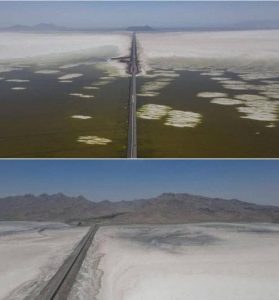
iran lake urmia dried
Gavkhoni Wetland: A Thriving Ecosystem Lost
Another report indicates that the Gavkhoni wetland in Isfahan province, central Iran, once a thriving ecosystem, has also fallen victim to the regime’s disastrous policies. An alarming 99% of the wetland has dried up, leading to the rise of dust centers and contributing to the deteriorating air quality in the region. The creation of these dust centers further amplifies the environmental disaster, endangering the health and well-being of millions of people.
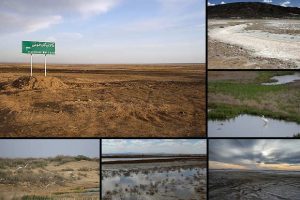
iran Gavkhoni Wetland
Environmental Catastrophe in Tehran and Beyond
The drying up of lakes and wetlands, coupled with the creation of micro dust and micro dust storms, has led to an environmental catastrophe in many parts of Iran, including Tehran. These dire conditions have resulted in the loss of many lives and the illness of millions of people. The gravity of the disaster is evident from the contents presented in the regime’s media.
According to the state-run Tasnim news agency on August 3, 2023 the Director General of Crisis Management in Isfahan Governorate reported that the Gavkhoni wetland has dried up by 99%, becoming a hub for dust, leading to 35 unhealthy air pollution days in Isfahan since the beginning of the year.
The once mighty Zayandeh Rood River, a lifeline for many communities in three provinces, is now running dry. The impact of the river’s depletion is seen in the wilting and falling of trees in the urban green spaces near its banks. The drying of fertile lands surrounding the river has further contributed to the rise of dust centers. This has not only devastated the urban green space but has also accelerated the phenomenon of land subsidence in Isfahan, posing a significant challenge for the city’s inhabitants.
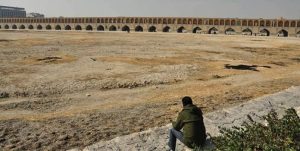
iran the Zayandeh Rood
The water stress has not been limited to the Zayandeh Rood area alone. The Director General of Isfahan Governorate Crisis Management revealed that 16,000 hectares of orchards have also been affected by water stress.
Furthermore, the drying up of Zayandeh Rood has contributed to an increase in the phenomenon of subsidence in Isfahan. The decline in the underground water level and subsequent land subsidence have become major challenges for urban areas in the region.
Environments experts have attributed the current environmental situation to the construction of improper dams and mismanagement by the regime.

iran tehran dust and air polution
Micro Dust and Air Quality Concerns
In addition, on July 31, 2023, the state-run Setareh Sobeh website reported that environmental activist Mohammad Darwish expressed concern about the drying up of Tehran. He highlighted that particles smaller than 10 microns in Tehran’s air have been increasing due to the drying of areas surrounding the city. He compared Tehran to a vacuum cleaner, depleting water resources that were once abundant in the region. The loss of wetlands in Tehran, which were once interconnected and vital for ecological stability, has exacerbated the situation. Rivers like Karaj River, Qom River, Jajrud, and Qarasu, which used to flow towards the wetlands, have now dried up. The report states, “This unfortunate circumstance is the outcome of years of neglect and underestimation of environmental projects in urban management.”
Alarming Death Toll and Air Pollution-Related Deaths
The health toll of the environmental catastrophe is staggering. According to Dr. Abbas Shahsoni, the head of the Air Health and Climate Change Department of the Ministry of Health and Medicine of Iran, approximately 21,000 citizens of the country, including 6,400 people in Tehran, die every year due to air pollution. From an economic perspective, the National Air and Climate Change Center of Iran’s Environmental Organization, citing data from the Ministry of Health, has revealed that air pollution in just 25 cities of the country causes about 30 billion dollars in damage annually.
The severity of the air pollution situation is further evident in Arak, the capital of Central Province. According to Alireza Mehrabian, the head of the laboratories of the General Directorate of Environmental Protection in the province, the hazardous air conditions and the presence of particles of less than 10 microns have forced offices and banks to close. This decision was taken by the province’s air pollution emergency working group, and schools were also closed in response to the ongoing air pollution conditions.
Official statistics indicate that Arak is one of the eight polluted metropolises in Iran, experiencing unhealthy air conditions for 27 days since the beginning of this Persian year(since March 21) and 138 days.
Simultaneously, the Director General of the Crisis Management Office of the Governorate of Sistan and Baluchistan reported on the impact of a “new wave of wind” in the Sistan region affecting five cities: Zabul, Zahak, Hamon, Hirmand, and Nimroz. As a result, 1,580 people from the region sought medical attention at hospitals and medical centers, with 102 of them currently hospitalized.
On July 21, 2023, the Vice President of Medical Sciences at Birjand University of Medical Sciences revealed that between July 12 and 19th, a total of 20,347 people went to the emergency room due to the presence of fine dust after a dust storm. Among these, 18,057 people were treated as outpatients, while 2,290 individuals required hospitalization.
Estimates indicate that South Khorasan province in the east of Iran is one of the top six provinces in the country concerning this issue, experiencing an annual presence of approximately “700000 tons of dust.”
The Silent Massacre: Rampant Extraction of Underground Water
Another harrowing environmental catastrophe perpetuated by the mullahs is the rampant extraction of underground water, facilitated by the construction of tens of thousands of wells around steel factories, other industrial facilities, and agricultural lands. This uncontrolled water extraction has triggered a devastating decline in underground water levels, unleashing a calamitous wave of land subsidence across the region.

iran earth subsidence
In an interview with the ISNA state-run news agency, an environmental expert shed light on the harrowing phenomenon of land subsidence plaguing Iran. This relentless process is fueled by the unbridled extraction of underground water, causing water depletion in the lower layers of the earth. As soil porosity and the weight of the upper layers exert pressure, the ground gradually sinks, resulting in the emergence of sudden cracks, fissures, and sinkholes.
The expert underlined the irreversible nature of land subsidence, as the emptied soil spaces, acting as natural reservoirs for underground water, become sealed off. This grim reality has earned the phenomenon the haunting moniker “the death of aquifers.” Nowhere is the threat more palpable than in regions like Yazd province, where hot, dry climates and scarce rainfall make aquifers the lifeline of communities. The decimation of these vital water sources could herald the collapse of human life in these areas.
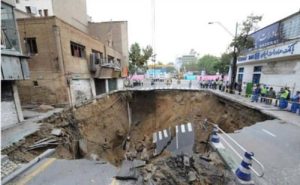
Archive picture of subsidence in Iran
Iran faces a dire predicament, with land subsidence occurring at an alarming rate. While developed countries consider an annual subsidence rate of four millimeters a crisis, some Iranian regions, such as the south of the Tehran Plain, Fasa Plains, and Jahrom, suffer annual subsidence rates reaching a staggering 40 to 54 centimeters – a chilling record that surpasses the world standard by a staggering 100 times.
The excessive extraction of water from aquifers over the past decades has triggered land subsidence across multiple provinces, including Tehran, Alborz, Isfahan, Fars, Kerman, Hamadan, Semnan, Qazvin, Razavi Khorasan, North Khorasan, and Yazd.
The consequences of land subsidence reverberate far and wide. Flooding engulfs affected areas, causing havoc and destruction to existing structures, such as residential buildings, roads, railways, power transmission lines, and pipeline networks. Moreover, sinkholes, cracks, and fissures rob people of the ability to utilize land for essential purposes like agriculture, services, and industries, exacerbating the environmental catastrophe.
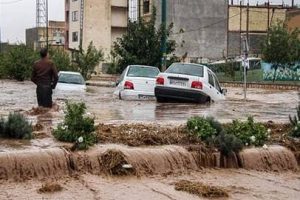
iran floods
Furthermore, subsidence puts pressure on clay layers of aquifers, causing toxic elements like arsenic to enter well water. This leads to technical defects and a severe decrease in water supply, forcing well owners to dig new wells at significant costs.
Moreover, subsidence has led to the destruction of land suitable for agriculture, with some sinkholes advancing up to 300 meters from rural residential areas in places like Abarkoh. This has left people concerned about potential loss of life and property.
Inadequate Budget Allocation and Outrage
Despite the grave magnitude of the environmental crisis, the regime’s budget allocation for environmental protection remains woefully inadequate. Astonishingly, a meager 3713 billion tomans (approximately 93 million dollars) has been earmarked for the country’s environmental protection organization in the upcoming year’s budget bill.
This glaring decision by the regime to allocate only a fraction of the necessary funds for environmental preservation, while lavishly funding military and religious institutions, has sparked outrage among experts and activists alike. The consequences of this gross imbalance extend far beyond the environment itself and have a substantial economic impact. Air pollution alone, fueled by the lack of proper funding for environmental protection, costs the nation approximately 30 billion dollars annually.
The repercussions of this neglect are felt across the nation, with critical environmental issues left unresolved due to the lack of financial support. From deteriorating air quality in major cities to the alarming loss of biodiversity in fragile ecosystems, the environment pays a heavy price for this budgetary neglect. Moreover, the economic toll of environmental degradation continues to escalate, burdening communities with healthcare costs lost productivity, and damage to infrastructure.
Urgent Need for Collective Action and Accountability
The environmental disaster unleashed by the Iranian regime’s misguided policies is nothing short of an epic crisis, posing a dire threat to the well-being and sustenance of millions of Iranians. The consequences, ranging from the drying up of vital water sources to the surging frequency of dust storms and suffocating air pollution, are nothing short of catastrophic. Immediate and decisive action is imperative to reverse this alarming trajectory and safeguard the environment for generations to come.
Across the nation, once-lush landscapes have transformed into arid wastelands, as the reckless depletion of water resources leaves communities parched and struggling. Meanwhile, the once-clear skies are now choked with dust and pollutants, endangering the respiratory health of countless Iranians and exacerbating respiratory illnesses.
This crisis is not confined to national borders; it is a matter of global concern. The international community must unite and demand accountability from the Iranian regime for its role in precipitating this ecological catastrophe. While the regime’s brutal repression of its people garners rightful condemnation, its silent massacre of thousands through dire environmental conditions cannot be overlooked.
With every passing day, more lives are placed in jeopardy, and the very fabric of Iranian society is threatened by these environmentally induced hardships. The time to act is now; collective efforts must be undertaken to implement sustainable practices and hold the regime accountable for its actions.
Unseen Victims: Iran’s Regime and the Deadly Impact on the Environment

